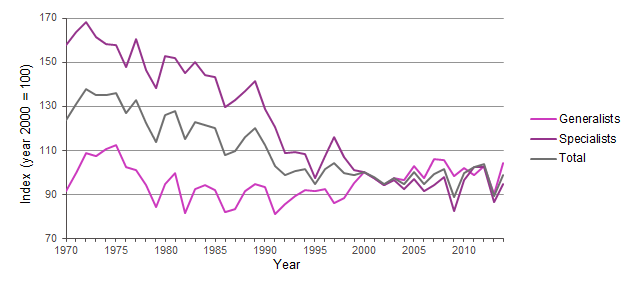We use some essential cookies to make this website work.
We’d like to set additional cookies to understand how you use forestresearch.gov.uk, remember your settings and improve our services.
We also use cookies set by other sites to help us deliver content from their services.
Indices of wild bird populations in the UK are produced annually by the Department for Environment, Food and Rural Affairs (Defra) in conjunction with the Royal Society for the Protection of Birds (RSPB), the British Trust for Ornithology (BTO) and the Joint Nature Conservation Committee (JNCC), and cover a range of species that are native to the UK.
The index for woodland birds was expanded in 2007 to cover 38 species, of which 12 are generalists and 26 are woodland specialists (those that breed or feed mainly or solely in woodland).
Since the early 1990s, the UK woodland bird index has generally been about 20 per cent below the level of the early 1970s, with the decline predominantly in woodland specialist species (Table 5.1, Figure 5.1).
Causes for the decline in woodland birds may include a lack of diversity in habitats and food sources, loss of habitats and food sources through damage caused by increasing deer populations, and a reduction in some migratory species following pressures in other parts of the world.
| Year | Total breeding birds | Farmland birds | Seabirds | Woodland birds | Woodland generalists | Woodland specialists |
|---|---|---|---|---|---|---|
| index (year 2000 = 100) | ||||||
| 2005 | 100.2 | 97.6 | 91.2 | 99.9 | 102.7 | 97.0 |
| 2006 | 99.9 | 96.3 | 94.3 | 94.7 | 97.5 | 91.6 |
| 2007 | 99.0 | 90.6 | 88.6 | 99.1 | 105.9 | 94.0 |
| 2008 | 100.5 | 92.5 | 83.5 | 101.6 | 105.4 | 97.8 |
| 2009 | 95.8 | 89.7 | 88.9 | 88.9 | 98.2 | 82.5 |
| 2010 | 97.2 | 86.9 | 86.1 | 99.6 | 101.7 | 96.4 |
| 2011 | 95.5 | 86.5 | 79.9 | 102.5 | 98.8 | 102.2 |
| 2012 | 96.6 | 87.4 | 76.9 | 103.7 | 102.6 | 102.4 |
| 2013 | 89.3 | 78.5 | 75.8 | 89.2 | 90.1 | 86.6 |
| 2014 | 94.2 | 79.9 | 83.0 | 98.9 | 104.0 | 94.5 |
Source: British Trust for Ornithology (BTO), Department for Environment, Food and Rural Affairs (Defra), Joint Nature Conservation Committee (JNCC), Royal Society for the Protection of Birds (RSPB).
Notes:
1. Based on data in Wild Bird Populations in the UK statistical release (Defra, October 2015).
Figure 5.1 UK populations of woodland birds

Source: British Trust for Ornithology (BTO), Department for Environment, Food and Rural Affairs (Defra), Joint Nature Conservation Committee (JNCC), Royal Society for the Protection of Birds (RSPB).
Notes:
1. Based on data in Wild Bird Populations in the UK statistical release (Defra, October 2015)
Cookies are files saved on your phone, tablet or computer when you visit a website.
We use cookies to store information about how you use the dwi.gov.uk website, such as the pages you visit.
Find out more about cookies on forestresearch.gov.uk
We use 3 types of cookie. You can choose which cookies you're happy for us to use.
These essential cookies do things like remember your progress through a form. They always need to be on.
We use Google Analytics to measure how you use the website so we can improve it based on user needs. Google Analytics sets cookies that store anonymised information about: how you got to the site the pages you visit on forestresearch.gov.uk and how long you spend on each page what you click on while you're visiting the site
Some forestresearch.gov.uk pages may contain content from other sites, like YouTube or Flickr, which may set their own cookies. These sites are sometimes called ‘third party’ services. This tells us how many people are seeing the content and whether it’s useful.